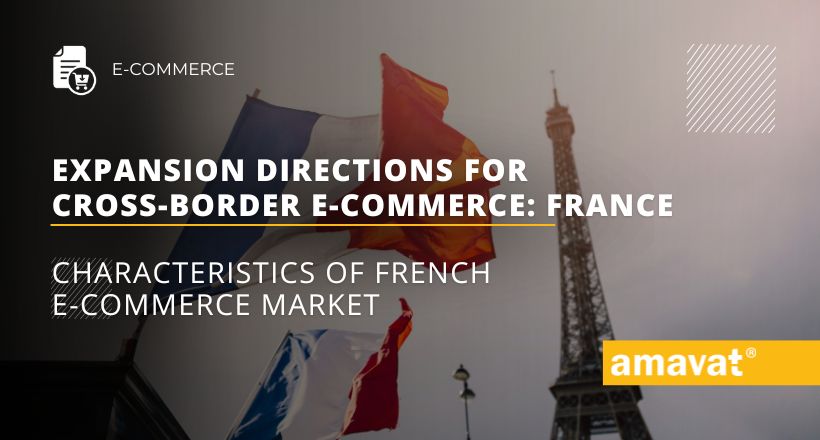Expansion directions for cross-border e-commerce: France
Just under a 2.5-hour flight separates us from a stroll along the Seine, a visit to the Louvre, or an exciting evening at the Moulin Rouge. However, France, the focus of this discussion, should be associated by Polish entrepreneurs not only with the opportunity for a proposal under the Eiffel Tower but also (and perhaps primarily!) with a powerful economy offering excellent opportunities for growth in cross-border trade in goods and services.
What is the economic situation under Emmanuel Macron’s leadership? Is e-commerce in France growing at a pace comparable to the growth rate in other European Union countries? The answers to these and many other questions can be found in the following article – we invite you to read on!
Market analysis
France is the second-largest economic powerhouse in the EU, with its GDP reaching nearly 2.8 trillion euros in 2023, according to Eurostat data. To put this number in context, the current leader, Germany, produced a GDP of 4.12 trillion euros, while Italy, in third place, achieved 2.09 trillion euros. By comparison, in Poland, the equivalent figure during the same period was 0.75 trillion euros. Additionally, GDP per capita in the country of the French Riviera reached 40.8 thousand euros last year, the tenth-best result among EU countries.
France has a population of 68,172,977 people. According to the World Bank, unemployment last year stood at 7.32%, exceeding the EU average by 1.22% (6.1%). Among the youth, the figure was 15.68%, showing significant improvement from 2022 when it was 17.47%. At the same time, the average wage level has been steadily increasing for over two decades – at the beginning of this century, it was 26,606 euros per year, while in 2019, it reached 39,152 euros. The pandemic caused the only drop during this period (37,605 euros in 2020), but two years later, the average wage exceeded 40,000 euros for the first time (41,706). The inflation rate – 5.7% – remains below the EU average of 6.4%.
Now, let’s take a look at the most active sectors of the economy in terms of newly established businesses. According to INSEE (National Institute of Statistics and Economic Studies in France), in 2023, 270,800 new entities were created in the business services sector. Second place went to companies engaged in trade (146,600), while the third spot was taken by household services (119,800). The next two positions were occupied by the education, health, and social work sector (100,900) and construction – 88,300 new companies. In total, over one million new businesses were established in France last year (1.0514 million), and you can find the full breakdown at this link.
E-commerce overview
One of the most crucial factors for assessing the market potential in the context of cross-border e-commerce expansion is the number of consumers making online purchases. Thanks to data published by Statista, we can compare how many people choose to order a selected item online in the top five European e-commerce markets. In 2023, the ranking (in millions) was as follows:
- United Kingdom – 47.79 users
- Germany – 42.48 users
- France – 28.78 users
- Spain – 18.44 users
- Italy – 18.39 users
The value of the e-commerce sector in France is characterized by steady growth. Starting from 2005, when it amounted to 8.4 billion euros, and ending with last year, which closed with a turnover of 159.9 billion euros, each successive 12 months saw a multi-billion increase, confirming the potential for expansion and allowing for optimistic predictions. For comparison, the total value of e-commerce in Europe during this period was around 566 billion euros, meaning France accounted for over a quarter of this figure. Thanks to PPRO, we also know that in 2022, the French spent the equivalent of 5.2% of their entire GDP online.
What is the share of e-commerce in the total retail sales value in the country by the Seine? According to data published by FEVAD (The Federation of e-commerce and distance selling), this ratio has been rising steadily since 2014 when it was 6%. Over five years, it increased by 3% (9% in 2019), and unsurprisingly, the highest peak occurred during the pandemic – exactly 12% in 2020-2021. The next 24 months saw a return to the previous trend, maintaining a stable 10% share. It’s also worth noting the breakdown of this value by individual industries, which directly allows you to assess the sales potential of your product category. According to a study conducted by Statista, the turnover per major segments is as follows:
- Fashion – 15.3 billion euros
- Electronics – 7.06 billion euros
- Food – 6.65 billion euros
- Beauty industry – 6.54 billion euros
- Furniture – 6.3 billion euros
- Beverages – 2.21 billion euros
- Toys and hobbies – 2.06 billion euros
- Media – 1.53 billion euros
French e-commerce users
According to the CRÉDOC report (Centre de Recherche pour l’Étude et l’Observation des Conditions de Vie – Research Center for the Study and Observation of Living Conditions), 80% of internet users made purchases online in 2023. This marks a rapid growth compared to just a decade earlier when the figure was 61%. The organization also provides insight into the percentage of individuals in various age groups who shop online, with the following rates:
- Ages 12-17: 52%
- Ages 18-24: 72%
- Ages 25-39: 81%
- Ages 40-59: 84%
- Ages 60-69: 74%
- Ages 70 and above: 53%
Moving on to transaction frequency, a survey of over four thousand people indicates that 12% of men and 10% of women place online orders at least once a week. At least once a month, 38% of men and 36% of women make online purchases. Several times a year, 43% of men and 49% of women shop online. When it comes to making a single purchase in the past 12 months, the figure is 4% for both genders, while 1% stated that they had never used e-commerce. For comparison, here are the results of a similar study (without gender division) conducted by FEVAD in 2023:
- At least once a week: 11%
- 2-3 times a month: 20%
- At least once a month: 17%
- Once every two months: 27%
- 4-5 times a year: 20%
- Less often: 4%
Importantly, the CRÉDOC study also provides the percentage of e-consumers in different social groups based on income levels. Among respondents who describe their income as low, 73% confirmed making purchases online. This was also true for 79% of the lower middle-income group and 84% of the higher middle-income group. As many as 85% of those who described their income as very good stated that they use e-commerce, suggesting that the price barrier should not be a significant obstacle when expanding into the French market.
Characteristics of French e-consumers
Let’s begin with the factors that most often influence the decision to order a product online. According to Statista, convenient home delivery is the top reason for 56% of e-consumers, followed by lower prices (54%) and avoiding crowds typically found in shopping centers (43%). The next factors, tied at 36%, are a wider selection of products and greater convenience. Other responses included 24/7 availability (35%), better comparison options (30%), and more detailed product information (27%). Additionally, thanks to Packlink PRO, we can look at the factors that most influence the loyalty of French e-consumers. These are primarily affordable prices (68.3%)* and good delivery conditions (45.6%). Special offers and discounts (42.8%) and product quality (41.6%) are also significant.
*At this point, it’s worth clarifying what “affordable prices” means. According to FEVAD data, the average order value in French online stores in 2020-2022 was 61, 60, and 65 euros, respectively, which helps to better understand how the French interpret this statement.
Most commonly purchased products and services
Thanks to FEDAV data, we can also look at the most frequently ordered items and services online in 2023. The statistics are as follows:
- Food: 56%
- Accommodation: 43%
- Clothing: 41%
- Cosmetics: 40%
- Tickets (transport): 39%
- Games and toys: 36%
- Bedding and other home textiles: 32%
- Tickets (theater, cinema, museum): 30%
- Electronics: 30%
- Furniture and decorations: 29%
- Financial services: 28%
- Food and beverages: 26%
- DIY and gardening: 26%
Returns
As reported in the March 2024 Statista Consumer Insights report, the most frequently returned product categories in France are:
- Ubrania – 21%
- Buty – 14%
- Akcesoria – 8%
- Książki, filmy i muzyka – 7%
- Elektronika – 7%
- Kosmetyki – 7%
It’s worth noting that these are not particularly high percentages, and at the same time, 54% of respondents confirmed that they had never returned an item they had ordered.
Cross-border orders
In 2022, DHL Group shared interesting statistics about the products they most frequently delivered cross-border to the French market during that period. These were:
- Clothing and footwear – 66%
- Electronics – 28%
- Sports accessories and hobby items – 22%
- Cosmetics – 16%
- Furniture and household goods – 13%
Major concerns and actions taken to combat inflation
Among the negative market changes most frequently mentioned by French e-commerce sellers were rising delivery costs (76% of respondents), reduced demand (75%), logistics disruptions (72%), and increased energy costs (63%). Despite the significant reported drop in demand, 83% of businesses decided to raise prices to counterbalance inflation, while only 53% reduced their margins. The smallest group (49%) postponed planned investments.
The largest online stores
Let’s start with an overview of the market situation – according to FEVAD, in 2022, there were approximately 207,000 e-shops operating in the French market, of which 69.9% did not exceed €100,000 in sales value. Another 22.8% had a turnover in the range of one million euros, while only 6.1% exceeded this amount but remained below 10 million. Only 1.1% of online sales websites in France can boast sales higher than 10 million euros, yet this group accounts for 76% of the market value. Another 16% falls within the 1-10 million range, and 6.8% belong to the third lowest category. The mentioned 69.9% of entities account for only 1.2% of the market.
In the TOP 10 largest players in terms of sales value, according to the eCommerce DB ranking, the following are listed:
- amazon.fr – $6.132 billion
- shein.com – $2.446 billion
- veepee.fr – $1.622 billion
- auchan.fr – $1.463 billion
- boulanger.com – $1.417 billion
- coursesu.com – $1.297 billion
- apple.com – $1.143 billion
- e.leclerc – $1.140 billion
- leroymerlin.fr – $1.018 billion
- cdiscount.com – $948 million
On the other hand, SimilarWeb prepared a ranking based on the share of internet traffic – according to their data, the French domain of the global e-commerce giant accounts for 24.98%, while the second place goes to leboncoin.fr with a share of 16.02%. Also on the podium is aliexpress.com (4.9%), followed by ebay.fr (3.39%) and cdiscount.com – 2.91%.
Is it worth considering e-export to France?
France is the second-largest economy in the European Union – with just over 68 million residents and a GDP of around 2.8 trillion euros, it represents only the tip of the iceberg regarding the potential for expansion into this market. To recall further key statistics, over 28 million people actively shop online, with almost half doing so at least once a month. It’s also worth noting that Amazon is the key player in French e-commerce, with a sales value of approximately 6.1 billion euros last year, surpassing second-place shein.com by over 3.68 billion.
Nevertheless, despite the numerous statistics supporting expansion, the final decision should be based on a thorough analysis of the sales potential of a given product category, which will indicate opportunities and risks, assess demand and costs, and consider the competition, thereby aiding in the planning of all key areas of entry into the new market.






